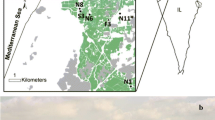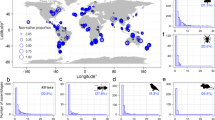Abstract
Since the 1960s, Japan has become highly dependent on foreign countries for natural resources, and the amount of managed lands (e.g. coppice, grassland, and agricultural field) has declined. Due to infrequent natural and human disturbance, early-successional species are now declining in Japan. Here we surveyed bees, birds, and plants in four human-disturbed open habitats (pasture, meadow, young planted forest, and abandoned clear-cut) and two forest habitats (mature planted forest and natural old-growth). We extended a recently developed multispecies abundance model to accommodate count data, and used the resulting models to estimate species-, functional group-, and community-level state variables (abundance and species richness) at each site, and compared them among the six habitats. Estimated individual-level detection probability was quite low for bee species (mean across species = 0.003; 0.16 for birds). Thirty-two (95% credible interval: 13–64) and one (0–4) bee and bird species, respectively, were suggested to be undetected by the field survey. Although habitats in which community-level abundance and species richness was highest differed among taxa, species richness and abundance of early-successional species were similar in the four disturbed open habitats across taxa except for plants in the pasture habitat which was a good habitat only for several exotic species. Our results suggest that human disturbance, especially the revival of plantation forestry, may contribute to the restoration of early-successional species in Japan.




Similar content being viewed by others
References
Askins RA (2001) Sustaining biological diversity in early successional communities: the challenge of managing unpopular habitats. Wildl Soc Bull 29:407–412
Asner GP, Rudel TK, Aide TM, DeFries R, Emerson R (2009) A contemporary assessment of change in humid tropical forests. Conserv Biol 23:1386–1395
Barlow J, Gardner TA, Araujo IS, Avila-Pires TC, Bonaldo AB, Costa JE, Esposito MC, Ferreira LV, Hawes J, Hernandez MIM, Hoogmoed MS, Leite RN, Lo-Man-Hung NF, Malcolm JR, Martins MB, Mestre LAM, Miranda-Santos R, Nunes-Gutjahr AL, Overal WL, Parry L, Peters SL, Ribeiro-Junior MA, da Silva MNF, da Silva Motta C, Peres CA (2007) Quantifying the biodiversity value of tropical primary, secondary, and plantation forests. Proc Natl Acad Sci USA 104:18555–18560
Beck J, Schwanghart W (2010) Comparing measures of species diversity from incomplete inventories: an update. Methods Ecol Evol 1:38–44
Betts MG, Hagar JC, Rivers JW, Alexander JD, McGarigal K, McComb BC (2010) Thresholds in forest bird occurrence as a function of the amount of early-seral broadleaf forest at landscape scales. Ecol Appl 20:2116–2130
Bibby CJ, Aston N, Bellamy PE (1989) Effects of broadleaved trees on birds of upland conifer plantations in north Wales. Biol Conserv 49:17–29
Bibby CJ, Burgess ND, Hill DA, Mustoe SH (2000) Bird census techniques. Academic Press, San Diego
Buckland ST, Anderson DR, Burnham KP, Laake JL, Borchers DL, Thomas L (2001) Introduction to distance sampling: estimating abundance of biological populations. Oxford University Press, Oxford
Chandler RB, Royle JA, King DI (2011) Inference about density and temporary emigration in unmarked populations. Ecology 92:1429–1435
Department of Population Dynamics Research (2006) Population projections for Japan: 2001–2050 with long-range population projections: 2051–2100. National Institute of Population and Social Security Research, Tokyo. http://www.ipss.go.jp/pp-newest/e/ppfj02/top.html
Dorazio RM, Royle JA, Söderström B, Glimskär A (2006) Estimating species richness and accumulation by modeling species occurrence and detectability. Ecology 87:842–854
Ellis EC, Ramankutty N (2008) Putting people in the map: anthropogenic biomes of the world. Front Ecol Environ 6:439–447
Ellis EC, Goldewijk KK, Siebert S, Lightman D, Ramankutty N (2010) Anthropogenic transformation of the biomes, 1700–2000. Global Ecol Biogeogr 19:589–606
FAO (2006) Global planted forests thematic study: results and analysis. Forestry Department Food and Agriculture Organization of the United Nations, Rome
FAO (2010) Global forest resources assessment 2010. Food and Agriculture Organization of the United Nations, Rome
Fischer J, Stott J, Law BS (2010) The disproportionate value of scattered trees. Biol Conserv 143:1564–1567
Forestry Agency (2007) Status of forest resources. Forestry Agency, Ministry of Agriculture, Forestry and Fisheries. http://www.rinya.maff.go.jp/j/keikaku/genkyou/index.html
Franklin JF, Maeda T, Ohsumi Y, Matsui M, Yagi H, Hawk GM (1979) Subalpine coniferous forests of central Honshu, Japan. Ecol Monogr 49:311–334
Fretwell SD, Lucas HLJ (1969) On territorial behavior and other factors influencing habitat distribution in birds. Acta Biotheor 19:16–36
Gardner B, Royle JA, Wegan MT, Rainbolt RE, Curtis PD (2010) Estimating black bear density using DNA data from hair snares. J Wildl Manag 74:318–325
Gaston KJ, Fuller RA (2008) Commonness, population depletion and conservation biology. Trends Ecol Evol 23:14–19
Gelman A, Hill J (2007) Data analysis using regression and multilevel/hierarchical models. Cambridge University Press, Cambridge
Inoue T (2005) Causes of butterfly decline in Japan. Jpn J Entomol (New Ser) 8:43–64 (in Japanese)
JBOSC (2010) Japan biodiversity outlook. Japan Biodiversity Outlook Science Committee (JBOSC), Ministry of the Environment, Tokyo. (in Japanese)
Kauppi PE, Ausubel JH, Fang J, Mather AS, Sedjo RA, Waggoner PE (2006) Returning forests analyzed with the forest identity. Proc Natl Acad Sci USA 103:17574–17579
Kéry M (2010) Introduction to WinBUGS for ecologists: a Bayesian approach to regression, ANOVA, mixed models and related analysis. Academic Press, San Diego
Kéry M, Spillmann JH, Truong C, Holderegger R (2006) How biased are estimates of extinction probability in revisitation studies? J Ecol 94:980–986
Kéry M, Dorazio RM, Soldaat L, van Strien A, Zuiderwijk A, Royle JA (2009) Trend estimation in populations with imperfect detection. J Appl Ecol 46:1163–1172
Lawton JH, Bignell DE, Bolton B, Bloemers GF, Eggleton P, Hammond PM, Hodda M (1998) Biodiversity inventories, indicator taxa and effects of habitat modification in tropical forest. Nature 391:72–75
Lehner B, Liermann CR, Revenga C, Vörösmarty C, Fekete B, Crouzet P, Döll P, Endejan M, Frenken K, Magome J, Nilsson C, Robertson JC, Rödel R, Sindorf N, Wisser D (2011) High-resolution mapping of the world’s reservoirs and dams for sustainable river-flow management. Front Ecol Environ 9:494–502
Lunn D, Spiegelhalter D, Thomas A, Best N (2009) The BUGS project: evolution, critique and future directions. Stat Med 28:3049–3067
MacKenzie DI, Nichols JD, Royle JA, Pollock KH, Bailey LL, Hines JE (2006) Occupancy estimation and modeling: inferring patterns and dynamics of species occurrence. Academic Press, Amsterdam
Meyfroidt P, Rudel TK, Lambin EF (2010) Forest transitions, trade, and the global displacement of land use. Proc Natl Acad Sci USA 107:20917–20922
Miyawaki A. 1994. Handbook of Japanese vegetation. Revised New Ed. Shibundo Pub, Tokyo. (in Japanese)
Myers N, Mittermeier RA, Mittermeier CG, da Fonseca GAB, Kent J (2000) Biodiversity hotspots for conservation priorities. Nature 403:853–858
Nagaike T, Hayashi A, Kubo M, Abe M, Arai N (2006) Plant species diversity in a managed forest landscape composed of Larix kaempferi plantations and abandoned coppice forests in central Japan. For Sci 52:324–332
Okuda S (1997) Wild plants of Japan. Shogakukan, Tokyo. (in Japanese)
Ovaskainen O, Soininen J (2011) Making more out of sparse data: hierarchical modeling of species communities. Ecology 92:289–295
Ralph CJ, Geupel GR, Pyle P, Martin TE, DeSante DF (1993) Handbook of field methods for monitoring landbirds. USDA For Serv Gen Tech Rep PSW-GTR-144
Royle JA, Dorazio RM (2008) Hierarchical modeling and inference in ecology: the analysis of data from populations, metapopulations and communities. Academic Press, Amsterdam
Royle JA, Dorazio RM, Link WA (2007) Analysis of multinomial models with unknown index using data augmentation. J Comput Graph Stat 16:67–85
Ruiz-Gutiérrez V, Zipkin EF, Dhondt AA (2010) Occupancy dynamics in a tropical bird community: unexpectedly high forest use by birds classified as non-forest species. J Appl Ecol 47:621–630
Sauer JR, Link WA (2002) Hierarchical modeling of population stability and species group attributes from survey data. Ecology 83:1743–1751
Schaffers AP, Raemakers IP, Sýkora KV, ter Braak CJF (2008) Arthropod assemblages are best predicted by plant species composition. Ecology 89:782–794
Scherber C, Eisenhauer N, Weisser WW, Schmid B, Voigt W, Fischer M, Schulze E-D, Roscher C, Weigelt A, Allan E, Beszler H, Bonkowski M, Buchmann N, Buscot F, Clement LW, Ebeling A, Engels C, Halle S, Kertscher I, Klein A-M, Koller R, Konig S, Kowalski E, Kummer V, Kuu A, Lange M, Lauterbach D, Middelhoff C, Migunova VD, Milcu A, Muller R, Partsch S, Petermann JS, Renker C, Rottstock T, Sabais A, Scheu S, Schumacher J, Temperton VM, Tscharntke T (2010) Bottom-up effects of plant diversity on multitrophic interactions in a biodiversity experiment. Nature 468:553–556
Schieck J (1997) Biased detection of bird vocalizations affects comparisons of bird abundance among forested habitats. Condor 99:179–190
Steffan-Dewenter I, Münzenberg U, Bürger C, Thies C, Tscharntke T (2002) Scale-dependent effects of landscape context on three pollinator guilds. Ecology 83:1421–1432
Sturtz S, Ligges U, Gelman A (2010) R2OpenBUGS: a package for running OpenBUGS from R. http://openbugs.info/w/UserContributedCode
Swanson ME, Franklin JF, Beschta RL, Crisafulli CM, DellaSala DA, Hutto RL, Lindenmayer DB, Swanson FJ (2011) The forgotten stage of forest succession: early-successional ecosystems on forest sites. Front Ecol Environ 9:117–125
Tscharntke T, Gathmann A, Steffan-Dewenter I (1998) Bioindication using trap-nesting bees and wasps and their natural enemies: community structure and interactions. J Appl Ecol 35:708–719
Violle C, Navas M-L, Vile D, Kazakou E, Fortunel C, Hummel I, Garnier E (2007) Let the concept of trait be functional! Oikos 116:882–892
Winfree R, Griswold T, Kremen C (2007) Effect of human disturbance on bee communities in a forested ecosystem. Conserv Biol 21:213–223
Yamagawa H, Ito S, Nakao T (2010) Restoration of semi-natural forest after clearcutting of conifer plantations in Japan. Landsc Ecol Eng 6:109–117
Yamaura Y, Amano T, Koizumi T, Mitsuda Y, Taki H, Okabe K (2009) Does land-use change affect biodiversity dynamics at a macroecological scale? A case study of birds over the past 20 years in Japan. Anim Conserv 12:110–119
Yamaura Y, Royle JA, Kuboi K, Tada T, Ikeno S, Makino S (2011) Modelling community dynamics based on species-level abundance models from detection/nondetection data. J Appl Ecol 48:67–75
Acknowledgments
We are grateful many land owners for their allowing field survey. Iwate central forestry owners association, Tamayama regional office, the municipality forestry department, regional offices of Iwate prefecture, Sotoyama laboratory of Animal Industry Research Institute, the members of the Tohoku regional forest offices assisted with the field survey. T. Amano, T. Akasaka, Y. Hirata, T. Matsumura, Y. Mishima, T. Morisawa, K. Okabe, K. Oono, H. Sugita, S. Sugiura, T. Takahashi, Y. Tomioka, T. Yagi, M. Yui, members of Tohoku Research Center of FFPRI and forest ecosystem management group of Hokkaido University provided us useful comments. Our manuscript was greatly improved by the comments from a reviewer, Robin Russell and members of USGS. Y. Yamaura was partially supported by JSPS KAKENHI (Grand-in-Aid for JSPS Fellows no. 21–7033 and Young Scientists B no. 23780153). H. Taki was partially supported by Global Environment Research Fund (S-9) of the Ministry of the Environment, Japan. We commiserate with land owners struck by 3.11 Tohoku region Pacific coast earthquake.
Author information
Authors and Affiliations
Corresponding author
Electronic supplementary material
Below is the link to the electronic supplementary material.
Rights and permissions
About this article
Cite this article
Yamaura, Y., Royle, J.A., Shimada, N. et al. Biodiversity of man-made open habitats in an underused country: a class of multispecies abundance models for count data. Biodivers Conserv 21, 1365–1380 (2012). https://doi.org/10.1007/s10531-012-0244-z
Received:
Accepted:
Published:
Issue Date:
DOI: https://doi.org/10.1007/s10531-012-0244-z




